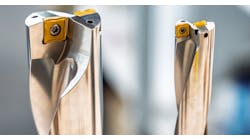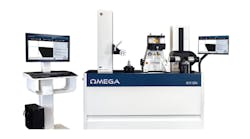Whatever level of experience or proficiency you may have in CNC machining methods and techniques, it’s always interesting to listen to the insights of experts on topics that interest you. You may learn something new — or you may have your confidence boosted once the expert reaffirms your positions.
As a product manager for The ANCA Group, Simon Richardson has been working with tool grinders for many years and has visited hundreds of tooling workshops all around the world. Meeting with customers in different conditions and with different grinding requirements has built his knowledge on how to set up a workshop to get the most out of the machines.
“Most of these tips would be part of an operators’ everyday activity, but it is always good to remind ourselves of some important housekeeping tasks,” Richardson said. “Following these tips will help grinders produce better tools, increase productivity, reduce breakdowns and extend the life of their machine.”
1. Keep things in order — Every interaction with your company builds your brand – including your workshop. A tidy, clean and structured workplace will also ensure equipment is always within reach and readily available. This saves time, means items are not lost or misplaced, it also looks better when you have visitors. Start a 5S program within your company. You will be surprised of the results.
2. Tightly maintain ambient and coolant temperatures — To produce accurate tools, it is critical that the ambient and coolant temperatures are stabilized within one degree of each other. A chiller will ensure the correct oil temperature is maintained, and is definitely worth the investment.
3. Use the best coolant system — A lot of companies don’t spend enough or see the value in a decent coolant system. Clean, filtered coolant will enhance the grinding performance and keep the machine looking like new. A good filtration system also will ensure the longevity of the machine and maximize the return on investment.
4. Handle and store precious items carefully — Items such as collet adaptors and grinding wheels can be expensive and are critical to producing quality tools, so they need to be stored and handled with care. Providing proper storage not only protects these valuable items but also keeps inventory visible and manageable.
5. Dress and condition grinding wheels regularly — Frequent dressing and conditioning of grinding wheels will ensure higher productivity. The wheels will perform better and the surface finish of the tools will improve. Worn wheels also makes your spindle work harder, putting such critical machine parts under unnecessary stress.
6. Keep collets clean and in good condition — This may seem obvious, but you will be surprised how many grinding shops use collets with grinding marks on the nose and dirt inside the collet. Sometimes, we just hang on to collets too long. Collets should be considered a consumable item and replaced as required.
7. Use high-quality blanks and the correct insert depth into the collet — You can’t breed a winning racehorse from mules. Similarly, if you want to produce a good quality tool, start with a good quality blank. Put the maximum amount of tool into the collet. ANCA’s 3D Cimulator can calculate the maximum insertion depth automatically, preventing grinding into the collet.
8. Read the machine manual — If you buy a new machine or the machine is not familiar to you, read the manual and documentation that comes with the machine. You will be amazed how much you will learn, and how much time you will save. You also may avoid some expensive mistakes.
Most companies also will have videos to help their customers understand how to use the machine: ANCA issues helpful tool grinding tips weekly basis. Follow #ToolTipTuesday on ANCA’s Instagram, Facebook or LinkedIn feed to ensure you don’t miss any.
9. Follow the maintenance schedule advised by the machine manufacturer — Dedicate time at the end of the week to conduct the stipulated maintenance tasks, and clean the machine. As with any technology, conducting preventative maintenance will be valuable in the long term. Preventative maintenance is better managed and has less impact on your company than "unplanned breakdown” maintenance.
10. Ensure that air supply and electrical power to the machine meet the machine manufacturer’s recommendations — Follow the guidelines as stipulated by the manufacturer in terms of air quality and electrical supply to the machine. You will be surprised how many costly breakdowns could have been avoided by following a few simple rules upon installation.
Simon Richardson is the MX machine product manager for ANCA CNC Machines. Contact him via LinkedIn.








